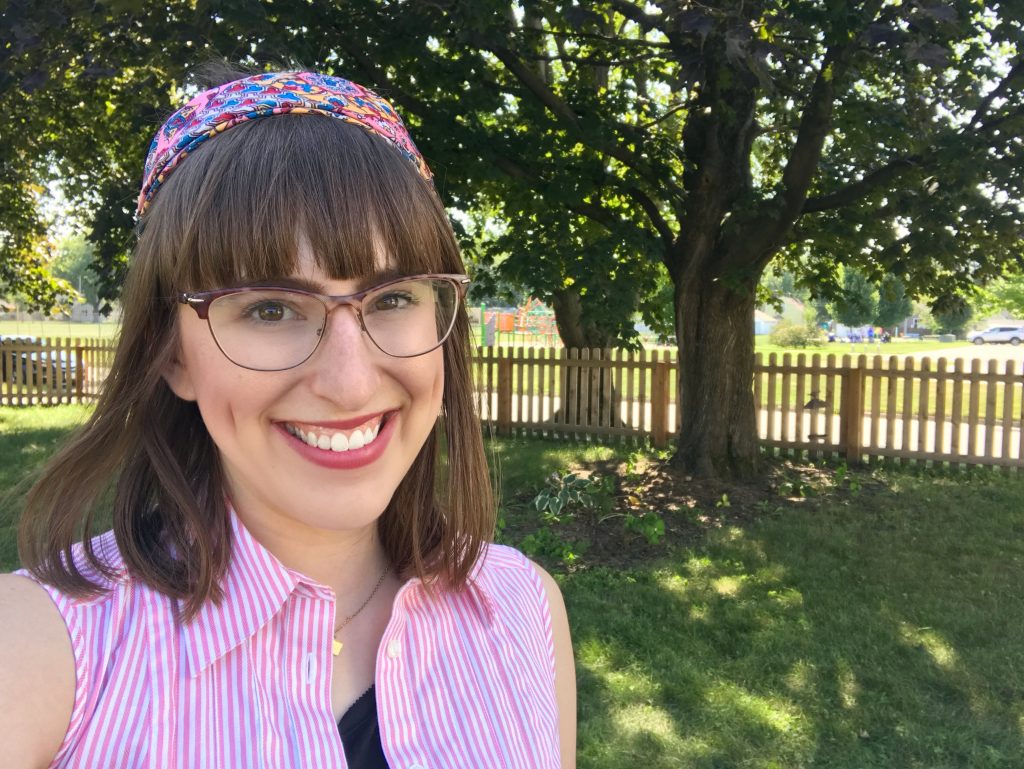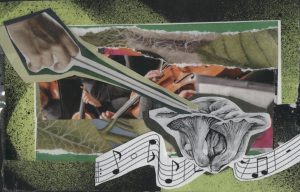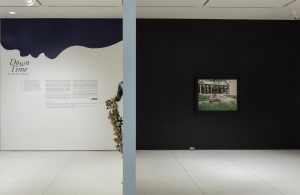Sustainability in the art world can mean a number of things, from using conscious art practices to upcycling materials, to ecological art which focuses on restoration. Environmental artists often explore the relationship between humans and nature, between man-made materials and natural environments, and they aim to work in a way that demonstrates harmony between the two.
From the banks of the Mississippi River to the small village of Northport, Michigan, we talked to four Midwestern artists who are creating sustainable, environmentally-engaged art and using reclaimed and repurposed materials.
Jenny Murphy
While at Washington University for her BFA, Jenny Murphy became very interested in the negative impacts of American consumerism. She started to consider what art could be like when it’s not confined to an inaccessible gallery, and it was then that she started defining herself as a “community artist.”
Murphy is the founder of Perennial, a sustainable art non-profit in St. Louis, that functions as a community workshop and store offering DIY and craft classes—everything from bookbinding to woven wall art —using reclaimed materials. The organization also works with social services agencies and uses art as a medium for social change.
Murphy says, “I know my work has always been about environmental issues, but I’ve always thought my role is to show the potential of using reclaimed materials to others. I think this can be a method to flip the consumer mindset we have. When people take a class at Perennial, they’re initially drawn in by making a cool work of art and learning a new process, but then they get a sustainability education along with it when they learn that work is made from trash!”
The goal of the Perennial workshops is not only to use reclaimed materials but to also inspire the creator to rethink their consumer behaviors and the impacts those behaviors have. Since consumption is a learned behavior, Murphy believes it can be unlearned as well.

She recently stepped down as Perennial’s Executive Director, in order to return to her art studio. Nevertheless, sustainable art that serves the community is still at the heart of her personal mission. She is currently working on public art murals and other public art projects that encourage reuse and circular economies.
“I spend about one day a week driving my truck up and down alleys in South St. Louis,” she says, “I’m often inspired by all the things I find that still have value. These things shouldn’t have been thrown away in the first place, but I’m glad I can show people how to fix them up and give them a new life. My brain operates in the functional, fix-it-up sense, so I love to find things that can be used.”
Ultimately, Murphy believes that art is a powerful tool for bringing people together around important issues. A space like Perennial, or a public art installation, can connect people from across the community and engage them in a community issue. This kind of gathering and engagement is an essential part of making real action happen, and Murphy believes this is one of the key roles she has to play as an artist engaged with climate activism.
Jenny Kendler
Jenny Kendler is a Chicago-based interdisciplinary conceptual artist and activist. Using reclaimed and repurposed art has always been a part of her art practice. Kendler was raised by a family who discussed the climate emergency, even back when she was a child. She says, “We would talk about climate change back in the 1980s when people still called it “global warming.’”
Kendler grew up in a home that composted, recycled, used hot water that was heated by the sun, and grew their own food. According to her, she thought this was a normal, baseline experience for how everyone lived in the world. It never felt like a hardship to her to do things like turn the compost pile, or separate colorful glass bottles at the recycling facility.
She now knows her childhood experiences were unique for the time but believes that through art we can show people ways of life they wouldn’t have previously considered normal or attainable. With art, we can demonstrate futures that could not otherwise be imagined and open people’s minds to them.
In partnership with the Chicago Park District, Kendler created a series of twelve Venus de Milo sculptures called, Sculpture—>Garden, that was cast entirely from soil and seeds, meaning the statues were biodegradable in themselves. As the statues crumbled and deteriorated, they transformed into a self-sustaining prairie. Kendler says these works, “recast the Human Exceptionalism” of the original, perfect white marble works, as something imperfectly beautiful. And it reminds us that “ we all belong to the natural world.”
Kendler is also an artist-activist. She is the first artist-in-residence for the Natural Resources Defense Council (NRDC)—an organization whose mission is to safeguard the earth through environmental policy and advocacy. She says it has been “tremendously rewarding” to work alongside others at the NRDC who believe the climate crisis is the most pressing issue of our time.
Kendler says, “My partnership with NRDC is a great example of how to support artists making activist public art. As opposed to some art and advocacy partnerships, where an artist is commissioned to create a very narrow or specific work, the NRDC understands what an artist needs to make work that is satisfying, and that doesn’t just fulfill a brief. They give me access to their team of people to create art that achieves our mutually-aligned goals.”
She is also an activist artist for the Extinction Rebellion (XR) Chicago chapter. Extinction Rebellion is a nonviolent civil disobedience group, that demands the government tell the truth about climate change, and bring about climate justice. Of her work with Extinction Rebellion, Kendler says, “When we make a just transition to an economy that is no longer reliant on fossil fuels, this must be a transition that is fair and just for everyone.”
Here Kendler’s words mirror Murphy’s—the climate emergency is a function of our society of broken systems and consumption. She agrees, “economics, capitalism, and discrimination are all human-made systems. That means they can be unmade by humans, too.”
Kendler thinks art is a powerful tool for demonstrating future possibilities. Art inspires people to view the world in new ways and imagine how things can be different in the future. She believes, “If we can’t imagine other ways to do things, we will never have a world without these broken systems. I think demonstrating this possibility is the most important role for artists and creatives.”
Jesse Hickman
Jesse Hickman lives in the small village of Northport, MI, but when he visits nearby Traverse City, he always stops at his favorite locally-owned whole bean coffee roaster, Higher Grounds. He’s asked the coffee roasters there to save him the 1lb and 5lb coffee bean bags they don’t need anymore, which Hickman uses in his art.
He began by priming and painting these bags white and using them for drawing paper for his other three-dimensional works, but then he says he “started to see the bags as works of art unto themselves” and his work with coffee bean bags has evolved into abstractions and sculptures themselves.
Hickman also works with scraps of wood, the majority of which he sources from discarded palettes at lumberyard and millwork facility burn piles. He says the Northport area has a very large facility that makes custom millwork. There is a lot of decorative trim and molding found inside the vacation homes in this area and the process of creating the trim creates a lot of scrap material. Hickman isn’t the only local who pulls unused scraps from this burn pile—it’s a popular spot to source good kindling—but Hickman uses these wood pieces in his artwork.
For Hickman, there is financial practicality to using discarded and reclaimed materials. As an efficient and minimal artist, he has built a career “figuring out a way to do things that don’t cost him much.” Even as an art student, when he was studying photography in Chicago in the 1970s, he used a Diana camera—a plastic-bodied toy camera—for his work. Despite not having fancy tools, he has built a satisfying art career over 45 years of work.
And of course, using reclaimed materials is personal, too. Hickman says, “I hate throwing stuff away. It’s criminal how much stuff gets thrown away that could be reused, usually because it’s not cost-effective to reuse.” Plus, like a vinyl collector who likes the scratches and pops in an old record, Hickman appreciates that the wood he collects has a history to it. It’s full of scratches and holes, and it has a history.
Hickman sums up his artists’ philosophy by saying, “I live simply and I work daily,” and this is mirrored in his ability to bring about beauty from everyday items others might first overlook.
Kristin Cassidy
Kristin Cassidy is originally from Anchorage, AK, where she was first drawn to scavenging for objects alongside bodies of water. Growing up, her family visited a village called Seldovia, which was so remote you had to take a boat to get there and it is blocked in on most sides by glaciers. It’s there Cassidy found beach glass for the first time.
“At the time, I didn’t realize that beach glass wasn’t natural, that it was manmade. I just picked it up and saw the beautiful colors of lavender and bright blue, and red, and yellows. And I started searching for it and collecting it,” Cassidy says.
On her first trip to St. Louis, she visited the Mississippi riverfront at a time when it was flooded, and saw a Lewis and Clark statue completely underwater, with only its hand exposed, holding a hat above the water. Even though the Mississippi River is why St. Louis the city is located where it is, most people who live in St. Louis have not been to the banks of the river. There are few breaks in the floodwall that separate the urban industrial city from the natural environment on the other side. But Cassidy has chosen this as her place to explore and reclaim art materials.
As she scours the river-bank, she collects anything with an expressive quality, this could be a rock with an interesting shape, or a twig that is twisted in a unique way, or a glass bottle from the 1800s. “I always say that my favorite thing I’ve found is the next thing I find. It’s the experience of finding things that really excites me,” she says, “and that moment of discovery that is such a rush.”
Though you have to keep an open mind when you’re scavenging for discarded materials, Cassidy focuses on collecting manmade objects, because there is both a human and natural history to those items.“Man makes the material and then nature turns it into something else overtime,” she says. Cassidy has discovered many odd and exciting objects, like an official notary seal for the City of St. Louis. “It still works,” she says,” “I just can’t imagine why someone would throw that in the river!” And a large brass skeleton key sticking out of a rock, completely covered in rust. “It was like finding the sword and the stone,” she said, “the way it stuck out of the rock and I had to work it free.” She loves objects like these, things people once used, that nature has taken over.
Working with the riverfront, she feels it communicates how it is treated. Usually, the riverbanks are overrun with trash. The river is polluted and brown, full of discarded styrofoam, and even washed-up strangely colored dead animals. “It’s shocking to see fisherman on the river,” Cassidy says, “and I worry about their health. I even worry about touching the river myself.” Over the years, she has researched the companies that have been allowed to dump their waste into the river — a practice that is still active today — as well as St. Louis’s history of improperly disposing of nuclear waste. When Cassidy collects contemporary fishing line — which she finds in abundance on the riverbanks — she creates photographic work with it, to express these health and environmental fears.
Cassidy wants people to understand the impact one single item, like a rusted spoon, can have. Seeing a photographic typology of all her collected spoons can help the viewer understand the sheer number of people who have dropped and discarded a spoon along the river over the years.
These artists demonstrate the beauty found in repurposed materials. They remind us that we don’t need new and that we have all we already need. But they also explore the relationship between these materials and the humans that interact with them over the years. And they help us imagine a harmony between humans and nature, in a way only art can.
FEATURED IMAGED: The artist is walking through a large green field with their back turned towards the camera. Photo courtesy of Kristin Cassidy.

Emily Stochl is a writer based in Cedar Rapids, Iowa. She writes regularly for Book Riot. She hosts and produces Pre-Loved Podcast, a weekly interview show about vintage and second-hand fashion. She is an advocate for sustainable living and climate action, and volunteers with the Sierra Club, Remake, and the Sunrise Movement. In her free time, she enjoys gardening, yoga, and reading. Find more of her work on her blog and @brumeanddaisy.



